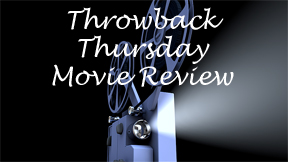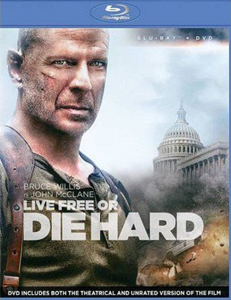Only 12 years pass between the third and fourth chapters of the “Die Hard” series, but the difference between the 20th and 21st centuries is striking. In “Die Hard with a Vengeance” (1995), the bad guys steal gold, and in “Live Free or Die Hard” (2007), they steal money digitally.
I don’t know how well the details hold up to expert scrutiny, but screenwriter Mark Bomback – who went on to write the last two “Planet of the Apes” films – effectively taps into the unease we feel in knowing that our money is represented by numbers on a computer screen as opposed to old-school bars of gold.
Extreme action
Meanwhile, director Len Wiseman (2012’s “Total Recall”) moves the saga into the new millennium with a gray and brown look and extreme action – even by “Die Hard’s” already extreme standards.

“Live Free or Die Hard” (2007)
Director: Len Wiseman
Writers: Mark Bomback (screenplay and story), David Marconi (story), John Carlin (article)
Stars: Bruce Willis, Justin Long, Timothy Olyphant
Similar to the early days of special effects, action movies went through a bigger-is-better phase in the 2000s, and “Live Free” succumbs to that when John McClane (Bruce Willis), driving a big rig, faces off with a bomber pilot who is tearing up the bridge he’s driving on.
There’s a cleanness to the close-up action, with the henchmen of Thomas Gabriel (Timothy Olyphant) dispatching security guards with the thwap of a silenced gun as they take over the nation’s infrastructure. Important operations are housed in clean, modern structures, and officials are dressed in crisp suits or uniforms. Gabriel reveals the façade.
Although Willis is not yet in his phoning-it-in phase, New York cop McClane acts like he’s seen it all before – but then again, he has. At multiple points, he takes out a helicopter despite being on the ground – once with a fire hydrant and once with a launched car. The creativity and execution of the stunts is notable, but I kind of miss the days when this wasn’t old hat to John.
Completing the odd couple
That’s not to say this is a walk in the park or that the stakes are frivolous. Justin Long, as hacker Matt, completes an odd couple as the brains to John’s muscle. McClane operates in a physical world, Matt in a digital world, and both skill sets will be needed in equal measure.
Mary Elizabeth Winstead, as McClane’s college-student daughter Lucy, disappears for an hour-long stretch, but it’s welcome when she returns.
Although her arc is a copy from “The Last Boy Scout” (she hates her dad, but not really), it’s amusing to see that Lucy has inherited her dad’s brashness. The film ends with a cute gag of Lucy and Matt being interested in each other to John’s chagrin; this should’ve been worked into the story earlier.

At least we can catch our breath when Kevin Smith cameos as uber-hacker Warlock. I welcome a laugh break amid the propulsive plot:
Warlock: “You a big fan of the Fett?”
McClane: “No. I was always more of a ‘Star Wars’ guy.”
Smooth operator
Olyphant is a smooth-operating villain; henchmen are numbers to him, like the financial data he toys with. One exception is his girlfriend, Maggie Q’s Mai. Like a lot of fourth films in action franchises, an Asian martial artist enters; in this case, it might be so McClane can say “I’m sick of this kung-fu shit.” If so, the movie is forgiven.
That said, the taunting McClane gives to Gabriel over the phone – even after the villain nabs Lucy – adds a jittery edge to an already intense plot. It’s almost too much.
But playing behind the action and insults, Bomback — working from a story he co-wrote with David Marconi (based on an article by John Carlin) — digs into topical issues. Ex-government worker Gabriel’s origin story is frustrating in its simplicity: He tells the U.S. government how easy it would be to shut down the country via hacking.
Using cold logic, they should either 1, do whatever it takes to keep this guy on their side, or 2, kill him. Instead, they fire and discredit him, turning him into an enemy. I’d almost be rooting for him except that he happens to be evil in addition to be wronged.
Gabriel’s motivations aside, “Live Free” is chilling in its portrayal of a “fire sale,” the shutdown of communications, transportation and power. Gabriel and his computer whizzes effortlessly achieve this. A click of a computer key turns every stoplight in D.C. green, causing accidents and gridlock.
Relatable chaos
With another press of a button, pipes send gas to a power station control center, blowing it up. This is showy stuff, but it’s relatable when we’ve recently seen the coronavirus shut down sports and immediately lead to toilet-paper hoarding. Chaos can ensue with remarkable speed.
Scariest of all, Gabriel toggles McClane’s 401(k) between its true balance and $0. FBI agent Bowman (Cliff Curtis) notes that Gabriel can download and then erase servers at one location, Woodlawn. He could then zero out everyone’s bank data and send the world back to the Stone Age. The scenario is terrifying.
I see a broad critique of government here, too, despite positive portrayals of Bowman and McClane. The title might be ironic, and the use of Creedence Clearwater Revival’s “Fortunate Son” over the end credits supports that theory.
We often obsess over the federal government’s massive centralized power, but it’s not often that we think “What if an even worse actor gained control of the apparatus?” For an extreme actioner, “Live Free or Die Hard” gives valid warnings.

